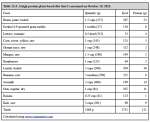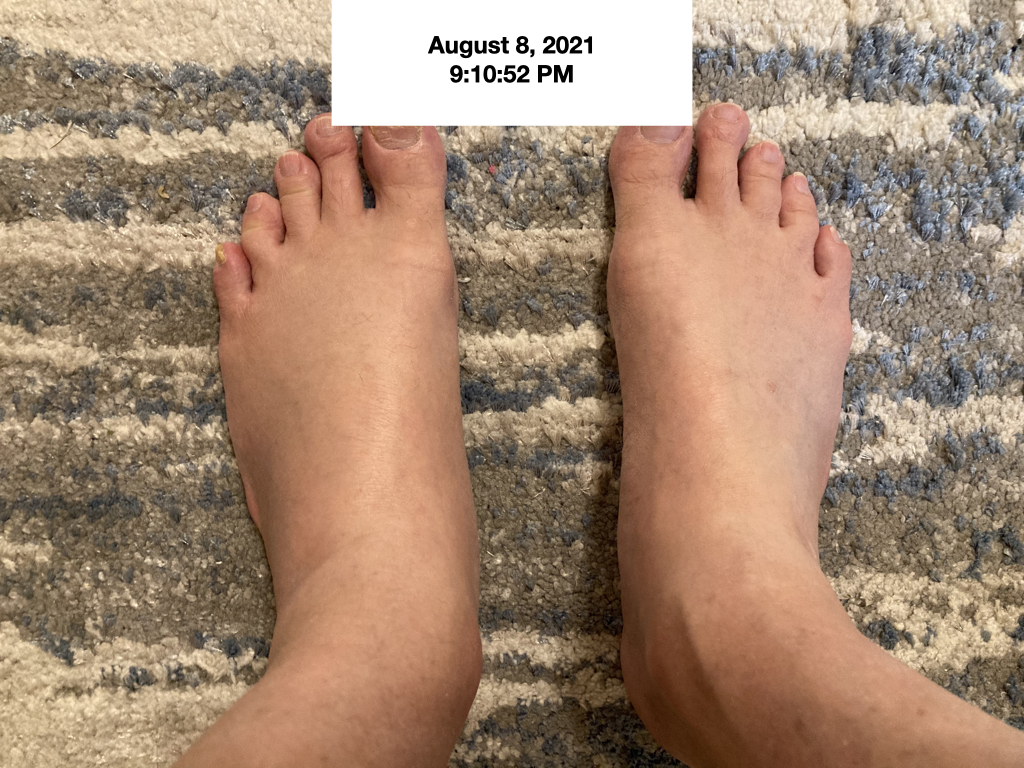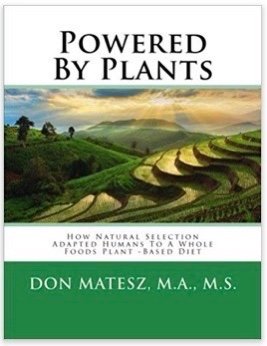How Every Disease Develops
Every disease develops gradually over a period of time. Once one understands how every disease develops, one can prevent and treat disease by addressing and removing the root of the disease.
Taoist macrobiotic medicine has a preventive perspective on disease, expressed in the following phrase from the Yellow Emperor’s Classic of Internal Medicine:

Hence, for several thousand years of development Taoist physicians focused on understanding how every disease develops, so that they could identify early signs of imbalance and take actions to avert health disasters by adjusting their own, and their patient’s diets and lifestyles. They discovered that all diseases arise from a single root and develop in a similar way.
Every disease develops over a long gradual process of apparently minor alterations in health that heralded the oncoming disaster and offered opportunities for self-correction. If you understand why disorder emerges and how it progresses from minor to major, you can interrupt the process using food and lifestyle adjustments, before it becomes difficult to uproot.
Although I learned of this science more than 30 years ago, during about 15 years of those 30, I ignored it, believing that Western medicine and nutrition had better ideas. I found out the hard way that the Taoist macrobiotic understanding of how every disease develops is correct. I violated the Order of the Universe and Human Nature, and developed degenerative diseases as a consequence. I hope readers will learn from my mistakes and avoid the problems I have created for myself.
Everything in the human body is made from nutrients and energy that we ingest from foods that we eat. This is axiomatic and undeniable. Therefore, all diseases are related to, rooted in or caused by the foods that we eat.
There are two basic types of diseases:
- Diseases of deficiency: These arise when one does not get enough of some essential nutrient or energy.
- Diseases of excess: These arise when one gets an excess of some essential nutrient or energy.
Although many people believe that almost everyone in modern nations suffers from one or another deficiency disease, true deficiency diseases are rare to non-existent in modern developed nations. According to a report from the U.S. Centers for Disease Control (CDC), less than 10% of the U.S. population had nutrition deficiencies for selected indicators. Although the incidence of vitamin D insufficiency was found to be up to 31% in selected subpopulations, vitamin D deficiency is not primarily due to diet but to lack of sun exposure.
In modern nations like the U.S.A., rich food is plentiful and cheap, and consequently almost all diseases are due to excess intakes of macronutrients. Major diseases of excess or affluence include:
- Cardiovascular disease, characterized by excess blood lipids and deposits of excess lipids and minerals in blood vessels.
- Cancer, characterized by excess growth of tissues composed of protein and fat.
- Diabetes, characterized by excess sugar and fat in the blood.
- Obesity, characterized by excess fat on the body.
- Hypertension, characterized by excessively high blood pressure.
- Acne, characterized by excess fat and sugar in skin cells.
And so on. However, these diseases do not just suddenly appear out of nowhere. They are end results of a long progression of development from minor to major disease.
Humans require foods containing an adequate amount of protein, fat, and carbohydrates, as follows:
- We require no more than 0.8 g protein per kg of body mass daily. This translates to a low of about 40 g for a very petite woman weighing less than 100 pounds to a high of about 90 g for a very large muscular male weighing 250 pounds. This amounts to no more than 10-15% of dietary energy as protein. Humans have no dietary requirement for animal protein because plant proteins provide all essential amino acids.
- We require only two fats in our diets, both of them unsaturated fats: no more than 17 g of linoleic acid (omega-6) and no more than 2 g of linolenic acid (omega-3), both of which are well supplied by plant foods. Since 20 g of fat provides only 180 kcal, and the average active person needs a total energy intake of at least 2000 kcal, we can see that we do not need more than 10-15% of calories as unsaturated fat.
- Since we require only 20-30% of our calories as protein and fat, it follows that we are designed by Nature to get 70-80% of our calories as carbohydrate.
Humans need abundant dietary carbohydrate (including fiber) for several reasons:
- First, our extraordinarily large brain and nervous system requires about 130 grams of glucose sugar daily for optimal functioning.,
- Second, all red blood cells must have glucose to function.
- Third, carbohydrate is the preferred fuel for the all muscular activity, especially high intensity activities. Since we require less oxygen to liberate energy from carbohydrates in comparison to fats, relying on fats for energy results in more labored breathing at rest and especially during exercise, and limits our endurance.
- Fourth, we need glucose sugar to completely oxidize (burn) fats, so insufficient carbohydrate intake actually prevents full utilization of fats for energy.
- Fifth, inadequate intake of glucose from dietary carbohydrate forces the body to break down dietary or body proteins to obtain glucose, which forces the liver and kidneys to deal with toxic urea residue from protein catabolism, and can result in loss of valuable muscle or organ tissue.
- Sixth, our cells cannot convert fats into carbohydrates.
- Seventh, we need dietary fiber for healthy bowel function and removal of bile acids and cholesterol from the gut.
By definition, "excess" means "more than required."
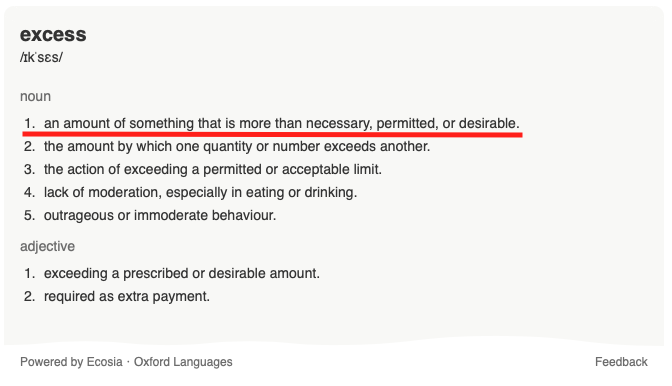
We know that humans require only 10-15% of calories as protein and only 10-15% as unsaturated fat. Animal muscles, eggs and milk typically provide much more than 10% of calories as protein or fat, most supply no carbohydrate, and none supply fiber.
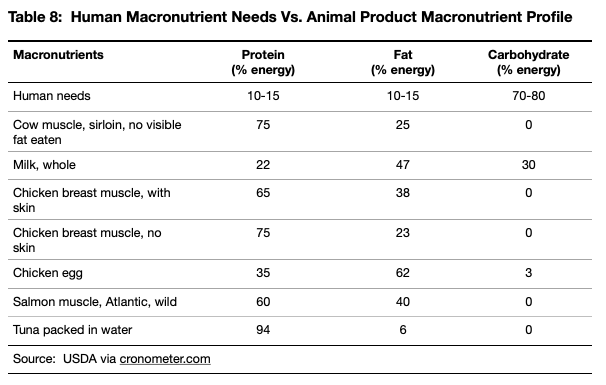
As shown in the table above, animal products provide 2-6 times as much protein per calorie and 2-4 times as much fat per calorie as we require. Therefore, it is undeniable that when humans consume animal products, by definition we unavoidably consume excess protein and fat, which is replacing essential carbohydrate.
National Academies of Science Food and Nutrition Board states that we have no dietary requirement for either saturated fats or monounsaturated fats, because we can make all the fats we need from carbohydrates when necessary. The National Academies of Science Food and Nutrition Board recommends we consume no more than 10% of calories as saturated fats, because saturated fats raise LDL cholesterol levels and any incremental increase in saturated fatty acid intake increases the risk of cardiovascular disease.
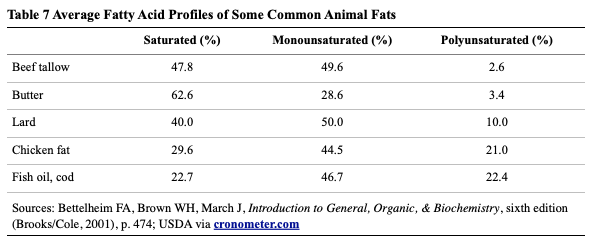
As shown, all types of animal fats––mammal, bird, and fish––provide more than 10% of energy as saturated fats. This means that when we consume animal fats, we automatically consume excess saturated and monunsaturated fats.
The National Academies of Science also states that humans have no dietary requirement for cholesterol, because every cell of the body can make cholesterol as needed. Since we have no dietary need for cholesterol, all dietary cholesterol is by definition excess cholesterol. This means that when we consume animal products in any amount, by definition we consume excess cholesterol.
The body strives to maintain health by excreting what it does not need. The normal avenues of excretion or discharge of excess are:
- Expiration
- Urination
- Defecation
- Perspiration
- Physical and mental activity
- Emotional expressions
When acutely exposed to an excess factor, the body adapts by adjusting its normal elimination and activities in order to discharge the excess factor(s) to the exterior. For a simple example, if one consumes excess fluids, the body increases urination and sweating, produces looser stools, and possibly a runny nose to remove the surplus. Various temporary symptoms such as coughing, fevers, chills, rashes, irritability, excitement, hyperactivity, and such may indicate a disorder of adjustment.
The body is always trying to relieve itself of excess burdens. If it can't get rid of the excess through normal elimination, it resorts to abnormal elimination, such as trying to push the excess out through the skin, resulting in various skin disorders and abnormal growths.
When chronically exposed to an excess factor, body systems begin to break down and fluids, cells, tissues, and organs alter in function or structure as a consequence. In general, disorder progresses in the following manner:
- Abnormal discharge and general fatigue
- Sluggish circulation with aches and pains
- Blood disorders with chronic discharge
- Accumulation of excess material in blood and tissues
- Storage of excess material in tissues and organs
- Nervous system disorders
- Spiritual disease
The following provides more detail:
Stage 1: Fatigue and abnormal discharge: When an individual acutely consumes energy or nutrients in amounts greater than the body can discharge through normal urination, defecation, perspiration, respiration, or physical or mental behavior, the overload leads to alterations in function aimed at moving the excess input out of the body, such as:
- coughing and sneezing
- increased defecation or urination
- increased perspiration and sudden skin rashes
- fidgeting, tapping, muscle spasms and tension, acute hyperactivity, rapid blinking
- irritability, anger, anxiety, excitability
- shivering, trembling, nausea, vomiting
- crying, shouting, screaming
If an individual recognizes his or her error and adjusts food intake, exercise and rest to allow for recovery, the body systems will discharge the excess nutrition within a few days. However, if the excess intake continues in spite of the symptoms, the rate of discharge will not keep pace with the rate at which the excess is entering the body. In this case the excess nutrients will begin to cause congestion in the circulatory system, leading to stage 2.
Stage 2: Sluggish circulation: As the rate of intake of excess nutrients from rich foods (particularly animal flesh, eggs, milk, and fat) exceeds the body’s ability to discharge the excess through the normal channels and the abnormalities that characterize stage 1, the excess nutrients begin accumulating in the blood. This creates thicker, stickier blood that can’t properly circulate, nourish, lubricate, or detoxify tissues and organs. The tissues don’t get enough oxygen and nutrients, and waste products accumulate faster than they are removed. As the tissues are deprived of oxygen and increasingly loaded with waste products, the individual begins to experience various aches and pains. The following recurrent signs and symptoms can indicate diet-induced sluggish circulation:
- muscle pain and tension
- headaches
- menstrual cramps
- numbness
- intermittent abdominal discomforts
- sleep disturbances
- breathing problems
- heart disturbances
- chills and fevers
- motion and coordination problems
- erratic emotions, mood and attitude
If the intake of excess nutrients is discontinued at this stage, the body can discharge them and return to healthy function within a few weeks. If the excessive intake continues, the individual will progress to stage 3.
Stage 3: Blood disorders: As a result of poor circulation (stage 2) the liver, spleen, and kidneys can not remove metabolic wastes from the blood as fast as they are entering the blood. Meanwhile, as a result of the continuing intake of excess rich food, the blood becomes saturated with superfluous cholesterol, fat, sugar, amino acids, minerals, and metabolic waste products. At this stage we find disorders involving temporary or slight changes in blood composition such as anemia, high or low blood sugar, high cholesterol, high triglycerides, and the like.
This decline in the blood quality disturbs circulation, resulting in growing toxicity of the various organs of the body, including the nervous system, causing more persistent emotional instability, blood and skin diseases, digestive disorders, and aches and pains.
Excess nutrients and waste products in the blood gradually but increasingly impairs circulation to the lungs, large intestine, liver, kidneys, and skin vessels and pores. Consequently, the organs can’t properly detoxify the blood and the blood, in turn, can’t properly nourish, moisten, and detoxify the skin and mucous membranes. Chronic or recurrent asthma, allergies, and sinus issues emerge at this stage.
In a healthy condition, the body controls the growth of abnormal cells. However, when the blood constantly contains excess nutrients that cells need for growth and replication (amino acids, fatty acids, cholesterol, etc.), and the immune system is impaired by poor circulation and accumulation of toxic wastes, abnormal cellular growth can occur unchecked, producing first benign tissue overgrowths like skin tags, moles, bunions, and so on. If left unchecked, this process eventually leads to malignant growths.
Thus, the emergence of chronic skin abnormalities heralds this stage of disease. At first the skin diseases may come and go with more or less inflammation or infection. If left uncorrected, the underlying systemic imbalance will lead next to more constant and serious disorders, generally in a step-wise fashion, starting with minor disorders like pimples, spots, rashes, moles, warts, bunions, dryness, etc.; progressing to more serious disorders like chronic eczema and psoriasis; and finally resulting in potentially deadly skin cancers.
As the blood quality declines, while also containing surplus nutrients, it gradually becomes a favorable environment for microbial or abnormal cellular growth, producing progressively serious blood disorders.
In this stage one may also experience irregular bowel movements, abnormal sweating, rapid respiration, frequent urination, bad breath, chronic vaginal discharges, and chronic unpleasant body odor. All of these emerge as the body is burdened by the excess and also attempts to use every possible channel of elimination to get rid of it and prevent accumulation of these wastes in the tissues.
Since the blood quality affects the nervous system function, as the blood becomes continuously and progressively sluggish and toxic, more chronic mental and emotional disorders arise, such as nervousness, oversensitivity, depression, hyperactivity, confusion, disorientation (loss of purpose), and an growing sense of alienation from one’s community and Nature.
To recover from this stage of disorder one will generally need to adhere to a proper program of diet, exercise and rest for several weeks to several months. At this stage additional interventions such as herbal medicines, acupuncture, and body therapies may also be necessary. If nothing is done one will eventually progress to stage 4.
Stage 4: Accumulation of excess: As the body continues to receive more than it can discharge, the excess accumulates in the blood. At this stage the blood and tissue levels of water, sugar, fat, cholesterol, amino acids, minerals, and metabolic waste products are chronically elevated. These put burdens on the internal organs, causing various functional disorders. The body becomes a fertile ground for infections by viruses, bacteria, and fungi. The accumulation of excess nutrients and fluids in tissues produces physical rigidity and loss of flexibility. One experiences chronic depression, worry, anger, impatience, frustration, fear, and nervousness, and an inability to approach problems with confidence and calm objectivity. One may find oneself unable to control one’s speech and expressions. Recovery from this stage may require several months at least, pending adoption of a healthy diet and adequate exercise and rest.
Stage 5: Storage and organic disorders: At this stage the body resorts to storing the excess water, sugar, fat, cholesterol, amino acids, minerals, and metabolic waste products in internal compartments, producing various accumulations or benign or malignant growths and tumors that change the organic structure of the internal tissues or organs. Organs become misshapen and dysfunctional. Problems at this stage include stones, spurs, abnormal tissue growth (e.g. endometriosis), cysts, arteriosclerosis, multiple sclerosis, and, in the most toxic situations, cancers. One’s mentality also becomes rigid, manifesting as prejudice, dogmatic thinking, delusions, and lack of empathy. If one adopts a proper program of diet, exercise, and rest, one can recover from this stage of imbalance in several months to a year. Otherwise one will progress to stage 6.
Stage 6: Nervous system disorders: Since the central nervous system is the information processing and decision-making center for the body, necessary for harmonious function of the various organs and tissues, the body does its best to keep this system from damage for as long as possible. The emergence of organic nervous system disorders such as dementia, Parkinson’s disease, and others indicates that the disease process has penetrated deeply and the body’s processes have been severely damaged. Other conditions indicative of this stage include physical paralysis, loss of coordination, suicidal ideation, schizophrenia, paranoia, and violent outbursts. If one can adhere to a proper program of diet, exercise, and rest, and get plenty of support from family or friends, one can recover from this stage within a period of 6 months to several years.
Stage 7: Spiritual disease: At this stage, which one may reach without clearly experiencing all of the previous stages, one refuses to take responsibility for one’s own thoughts, words, deeds, and actions. One blames other people, Nature, or God, and refuses to change any habits. Other signs and symptoms of this level of sickness include:
- Self-pity
- Selfishness
- Carelessness
- Dishonesty
- Covetousness
- Lack of self-discipline
- Meekness
- Self-indulgence
- Disloyalty
- Disrespectfulness
- Cowardice
- Inhospitality
- Negligence
- Indolence
- Dependence
- Entitlement
- Spitefulness
- Arrogance
In fact, arrogance – rebellion against Nature, Reality, Truth – is not only the final result but also the first cause of all other diseases and disorders.
This is the deepest level of sickness, for unless one is sick of being sick, one can’t become well. On the other hand:

Recent Articles
-
Vegan Macrobiotic Diet For Psoriasis
Sep 05, 23 06:36 PM
Vegan macrobiotic diet for psoriasis. My progress healing psoriasis with a vegan macrobiotic diet. -
How Every Disease Develops
Aug 04, 23 06:22 PM
How every disease develops over time, according to macrobiotic medicine. -
Why Do People Quit Being Vegan?
Jun 28, 23 08:04 PM
Why do people quit being vegan? How peer pressure and ego conspire against vegans. -
Powered By Plants
Mar 16, 23 08:01 PM
Powered By Plants is a book in which I have presented a lot of scientific evidence that humans are designed by Nature for a whole foods plant-based diet. -
Carnism Versus Libertarianism
Dec 30, 22 01:55 PM
Carnism Versus Libertarianism is an e-book demonstrating that carnism is in principle incompatible with libertarianism, voluntaryism, and anarchism. -
The Most Dangerous Superstition Book Review
Nov 15, 22 08:46 PM
Review of the book The Most Dangerous Superstition by Larken Rose. -
Plant-Based Diet Is Best For Health Protection: Meta-Review
Oct 17, 22 11:22 AM
A plant-based diet is best for health promotion according to a meta-review of more than 300 reviews published 1950-2013. -
How I Fixed Foot Swelling (Lower Limb Edema)
Sep 29, 22 02:07 PM
How I fixed foot swelling (lower limb edema) with a lactovegetarian whole foods plant-based diet.
